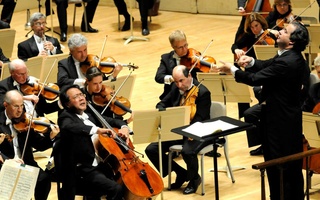The Boston Symphony Orchestra (BSO) performed Beethoven’s Third (“Eroica”) and Fourth Symphonies under James Levine on February 19 with an ironically self-possessed mood of adolescent naïveté. Cleverly and convincingly, the BSO managed to make the Beethoven symphonies come alive with a sense of artistic honesty and real intensity of spirit.
The two symphonies, often pointed to as the first flowering of Beethoven’s full Romanticism, are suffused with an emotional variety and exuberance that often gets suffocated under the reverence bestowed upon them as artistic milestones. An institution as well established as the BSO and a conductor as august as Levine could easily compound the problem, but they proved to be far too skillful to fall into such a trap. They chose to take on a role—not that of the priestly stewards of sacred sound, but almost that of a preternaturally talented youth orchestra playing the “Eroica” for the very first time. It is high praise rather than understatement to call the performance “fun.”
In some sense, repertory concerts are artistically riskier than premieres. Both performers and listeners tend to engage new music with greater spontaneity and sincerity. To the audience, novelty grants the right to have an opinion; to the musicians, it offers a chance to experiment, play, and even occasionally be less than perfect.
In contrast, performances from the standard repertoire, like the Beethoven symphonies, offer dozens of ways to lapse into ceremonious inauthenticity. The audience, aware that they are listening to a top orchestra under a celebrated conductor performing the masterworks of one of the greatest composers, strains to rise to the occasion with a reaction of appropriate greatness. When the quality of the composition and the technique of the performer are beyond dispute, the audience’s response is a foregone conclusion, and the concert becomes a set of protocols rather than a genuine performance.
For the performers, then, the challenge of crafting a concert of canonical anchors like the Beethoven symphonies is to avoid easy recourse to the habit of flawless dignity. Consummate artistry involves not only the meaningful realization of a composition, but the further ability to destroy and then resurrect its grandeur—to connect with the inner greatness of the work while stripping away the pomp that surrounds it. The goal is for the audience to like it not because they are supposed to, but because they can’t help it.
Levine is excellent at making Beethoven into less of a god and more of a human. He visibly and audibly revels in the symphonies, and one of the many joys of being in the concert hall rather than listening to a recording is in catching the gleeful brio Levine exudes. Sitting rather than standing at the podium (due to well-chronicled health problems over the past four years), he swivels fluidly back and forth like a six-year old left alone in a big office chair, dancing his feet across a wooden support bar like some frenetic organist pedaling a Reger fugue. Occasionally, you could hear him calling “Dyet! Dyet! Dyet!” in the syncopated passages of the first movement of the “Eroica” or loudly exhaling a sensual, satisfied “Syaaah!” at the climax of the second movement of the Fourth. While a certain sort of listener might find those noises distracting, it is energizing to realize that the even best conductors love the music they do because it fills them with the same sort of impulse to sing along and dance that anyone catches from music they love.
The Fourth Symphony actually preceded the Third on the program, a decision that allowed the concert to end with the somewhat more invigorating finale of the latter—but also prevented the subtler charms of the less frequently performed Fourth from disappearing beneath the pyrotechnics of its younger sibling. Levine’s rendition of the Fourth danced ahead at a quicker pace than most performances, particularly in the second and third movements, but on the whole the sprightly tempo allowed a refreshing balance of line and punch where one is normally sacrificed for the other.
The emotional gamut spanned by the “Eroica” gave it the flavor of a show piece, but that never cheapened it—in fact, the extra swagger affected by the BSO is really something missing from other interpretations. Sterling solo and ensemble work in the wind section stood out in the third movement, as in the symphony as a whole. Even in the dolorous intensity of the second movement, the emphasis on the starkness of the horns turned Beethoven’s exploration of grief into more of a public ritual of loss than an introverted sorrow—another interpretive move that helped the concert transcend the typical Beethoven performance.
As the BSO, like all orchestras, works hard to expose new audiences to the world of classical music, repertory concerts continue to play a disproportionate role in drawing first-time listeners. As the music world tries to balance the demands of sustaining the canon with its mission to discover and promote new works in the classical tradition, it becomes all the more pressing that repertory concerts speak with the same immediacy and freshness as “new music” performances if there is to be any audience left at all.
Read more in Arts
The Scenic RouteRecommended Articles
-
Guests Bring Flair To Traditional BSOVisiting conductor and pianist added vibrancy to a typically understated BSO
-
 You're Not Old? Awesome, You Get in Cheaper.
You're Not Old? Awesome, You Get in Cheaper. -
Mahler's 'Resurrection'On Friday, October 9 at Symphony Hall, the BSO took on this challenge with impressive spirit, and succeeded in bringing those present a thoroughly transcendental aesthetic experience.
-
Beethoven's Night of FashionOn February 3 at Symphony Hall, the Boston Symphony Orchestra (BSO) will be showcasing works by fashion students from around the Boston area.
-
 Striking BSO Not Lost Without Levine
Striking BSO Not Lost Without Levine -
Chung Shines in Bold BSO PerformanceThe BSO coupled restraint with its trademark power to spellbinding effect.













